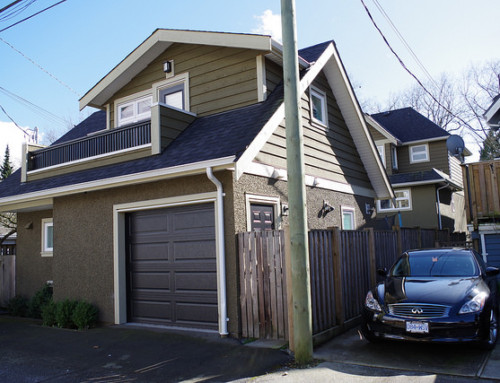In a recent blog on the satellite family as part of a series on Speculation and Vacancy Tax we learned that with regard to ownership of a residential property, each member must file their own annual declaration. That time is also when each member can claim exemptions they qualify for and those exemptions generally fall into residential properties in these three main categories:
- The first one being a property occupied by owner
- The second one is a property occupied by a tenant
- The third is properties that are currently under development
1. Let’s talk about the ‘occupied by owner’ exemption
The occupied by owner exemption is available to all Canadian citizens and permanent residents who are not members of a satellite family. It is the place where the owner occupies the residence more so than anywhere else in the calendar year. So a primary place of residence again does not take the definition that is normally associated with principal residence for the purposes of the Income Tax Act.
Owners with multiple homes – be it a vacation property or a secondary residence can only designate one property as their primary place of residence. We must then remember that because the primary place of residence is defined as the location at which the owner occupies -more so than anywhere else – as their place of residence.
Now, unless it is for work or medical reasons or due to legal separation or divorce, spouses must designate the same property as their primary place of residence. In other words, you cannot designate separate properties as the place of residence for spouses.
Please note that the Principal Residence Exemption here for the Speculation Tax is only available to Canadian citizens and BC residents for income tax purposes. The Principal Residence Exemption is only available to Canadian citizens or permanent residents of Canada who are also BC residents for income tax purposes. So if you don’t meet those conditions the Principal Residence Exemption is not available to you.2. Homes that are occupied by a tenant
2. Homes that are occupied by a tenant
The other primary exemption available is for homes that are occupied by a tenant.
Now for 2018, the home need only be occupied by a tenant for three months out of the calendar year. In future, the home will need to be occupied by a tenant for six months out of the calendar year to qualify. It’s also important to know that the residency must be for terms of at least one month or more. You can combine multiple tenancies to meet that six month annual minimum.
When considering ‘the occupied by tenant exemption’ it’s important to know that the provincial government makes a distinction between arms-length tenancies and non arms-length tenancies.
What are these?
A tenancy at arm’s length is one where neither party – the landlord or the tenant – has an advantage or a privilege over the other. In other words the rent charged by the landlord is fair market value rent and of course, as a tenant you want to pay the lowest amount of rent possible.
Not arm’s length tenancies, for example, are typically tenancies between family members. It could be tenancies between friends and could also include tenancies between employer and employee. Effectively the tenancy relationship might not be on fair market value terms. That’s kind of the defining criteria with respect to non arm’s length tenancies.
We find that the exemptions for arm’s length tenancies are pretty straightforward.
All owners would be eligible for the occupied by tenant exemption if the tenant has no advantage with regards to the tenancy due to a family or a personal relationship with the owner or owners. Also, there needs to be a written tenancy agreement in accordance with the Residential Tenancy Act and the tenant must also occupy the home as their place of primary residence as well.
So a tenant cannot use the property as a vacation home or a temporary home. It must be their primary place of residence.
In non arm’s length tenancies the provincial government considers two main categories:
One is for owners who are Canadian citizens or permanent residents and in that case the tenant needs only to occupy the property as their place of primary residence for each calendar month. So if you would add up the calendar months that the tenant occupies the property and if you meet the six-month minimum, you’re good to go.
The other category that the provincial government looks at is with respect to owners who are not Canadian citizens or permanent residents – in other words – foreign owners and members of satellite families.
Now if you happen to be a foreign owner or a satellite family and you have an on arm’s length tenancy the criteria to meet is a lot stricter:
- Your tenant must be a Canadian citizen or a permanent resident
- Your tenant must be a BC resident for income tax purposes on December the 31st
- Your tenant must also not be a member of a satellite family themselves
Lastly, and this one is likely the harder one to meet – your tenant must have income in a given year that is greater than three times the fair market value of rent of the entire building that you are renting out.
So in a single-family home, if it’s a basement suite that you’re renting out, it looks at the fair market value of rent of the entire building upstairs and downstairs. As you see, typically that criteria is kind of hard to meet and you might find that you won’t be able to use the Occupied by Tenant Exemption if:
1. You are a foreign owner or a member of a satellite family
2. Your tenant doesn’t meet that income qualifying criteria
3. Land under Development
The final exemption that I’d like to look at with you is one for ‘land under development’.
Owners are exempt from the Speculation Tax if they undertake reasonable steps – without undue delay – to either develop the property or renovate the property. Now, the provincial government looks at building activities to determine whether or not you are developing land.
Building activities, as considered by the provincial government might be where you are:
- Applying for financing
- Entering into contracts for design for engineering or for building the property
- Demolishing the property or a clearing
- Excavating the land
- Actually constructing the property
- And of course, if you are undertaking any other reasonably necessary activity to develop the property or to renovate the property – that would also be considered as building activities.
Believe it or not, there’s actually a much longer list available on the government website – here is the link: https://www2.gov.bc.ca/gov/content/taxes/property-taxes/speculation-and-vacancy-tax/exemptions-speculation-and-vacancy-tax – so do check that list but if you have any of those activities undergoing – your property might be exempt for land under development from the BC Speculation Tax.
If you want to establish exactly which exemption opportunities you qualify for in your particular residential property tax situation, email of phone me and we can set you straight for 2019 and beyond.
You can view this post HERE. YOUTUBE LINK to part 2 as it stands https://www.youtube.com/watch?v=LEmyUT-XIHU
If you found this post useful, please share with others who might benefit from these tax tips pertaining to real estate.
Subscribe to our JLT CPA email list where I send out emails related to tax matters for real estate every couple of weeks or so with tax tips to serve you.














